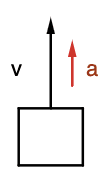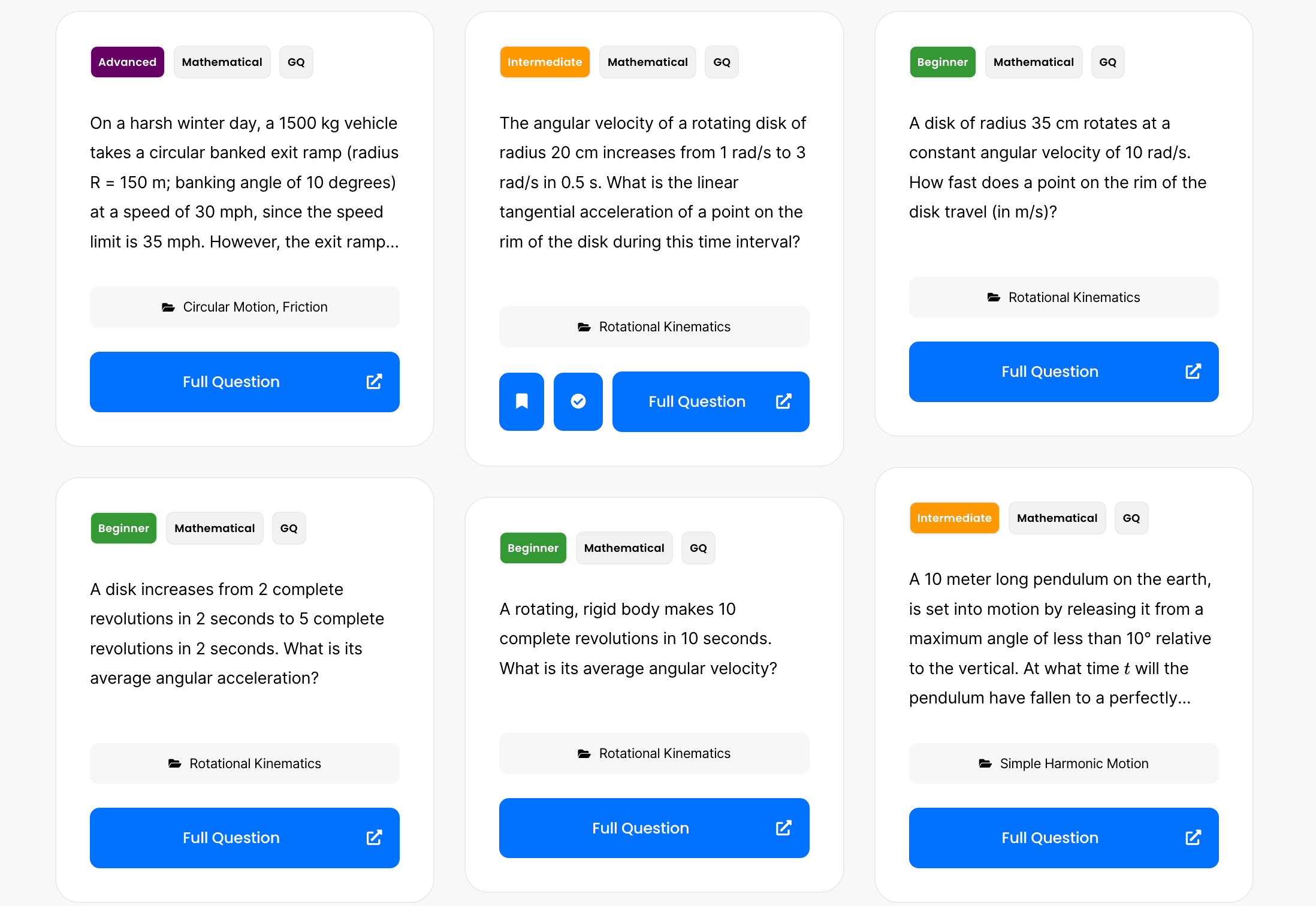| Step | Derivation/Formula | Reasoning |
|---|---|---|
| 1 | \tau = r \times F | Torque (\tau) is calculated as the product of the radial distance (r) and the force applied (F). The force here could be the result of the weights due to the masses. |
| 2 | F = mg | Force due to gravity is calculated by multiplying the mass (m) by the acceleration due to gravity (g, approximately 9.8 \, \text{m/s}^2). |
| 3 | \tau_{\text{left}} = 0.5 \, \text{m} \times 0.1 \, \text{kg} \times 9.8 \, \text{m/s}^2 \tau_{\text{left}} = 0.49 \, \text{Nm} |
The torque produced by the mass on the left end. The radial distance here is half a meter since it’s at the end of half the length of the meter stick. |
| 4 | \tau_{\text{right}} = 0.5 \, \text{m} \times 0.15 \, \text{kg} \times 9.8 \, \text{m/s}^2 \tau_{\text{right}} = 0.735 \, \text{Nm} |
The torque produced by the mass on the right end, using similar calculations as for the left side. |
| 5 | \text{Net } \tau = \tau_{\text{right}} – \tau_{\text{left}} \text{Net } \tau = 0.735 \, \text{Nm} – 0.49 \, \text{Nm} \text{Net } \tau = 0.245 \, \text{Nm} |
Calculate the net torque on the meter stick. Since the stick is in rotational equilibrium, this net torque has to be counteracted by the tension in the string. |
| 6 | T \times 0.5 \, \text{m} = 0.245 \, \text{Nm} | Set the torque due to the tension (T) equal to the net torque. The distance from the pivot to the left end is 0.5 \, \text{m}. |
| 7 | T = \frac{0.245 \, \text{Nm}}{0.5 \, \text{m}} T = 0.49 \, \text{N} |
Solve for the tension T in the string supporting the left end of the meter stick. |
| 8 | T = 0.49 \, \text{N} | Final answer: The tension in the string supporting the left end of the meter stick is 0.49 Newtons. |
Phy can also check your working. Just snap a picture!

The box is sitting on the floor of an elevator. The elevator is accelerating upward. The magnitude of the normal force on the box is
A block starts from rest at the top of a 50° incline. The coefficient of kinetic friction between the block and the incline is 0.4. If the block reaches a velocity of 7 m/s at the bottom of the incline, what is the length of the incline?

A system consists of a disk rotating on a frictionless axle and a piece of clay moving toward it, as shown in the figure above. The outside edge of the disk is moving at a linear speed v, and the clay is moving at speed \frac{v}{2}. The clay sticks to the outside edge of the disk. How does the angular momentum of the system after the clay sticks compare to the angular momentum of the system before the clay sticks, and what is an explanation for the comparison?
Angular momentum cannot be conserved if
A 0.5 mm wire made of carbon and manganese can just barely support the weight of a 70.0 kg person that is holding on vertically. Suppose this wire is used to lift a 45.0 kg load. What maximum vertical acceleration can be achieved without breaking the wire?
.49 N
By continuing you (1) agree to our Terms of Sale and Terms of Use and (2) consent to sharing your IP and browser information used by this site’s security protocols as outlined in our Privacy Policy.
| Kinematics | Forces |
|---|---|
| \Delta x = v_i t + \frac{1}{2} at^2 | F = ma |
| v = v_i + at | F_g = \frac{G m_1m_2}{r^2} |
| a = \frac{\Delta v}{\Delta t} | f = \mu N |
| R = \frac{v_i^2 \sin(2\theta)}{g} |
| Circular Motion | Energy |
|---|---|
| F_c = \frac{mv^2}{r} | KE = \frac{1}{2} mv^2 |
| a_c = \frac{v^2}{r} | PE = mgh |
| KE_i + PE_i = KE_f + PE_f |
| Momentum | Torque and Rotations |
|---|---|
| p = m v | \tau = r \cdot F \cdot \sin(\theta) |
| J = \Delta p | I = \sum mr^2 |
| p_i = p_f | L = I \cdot \omega |
| Simple Harmonic Motion |
|---|
| F = -k x |
| T = 2\pi \sqrt{\frac{l}{g}} |
| T = 2\pi \sqrt{\frac{m}{k}} |
| Constant | Description |
|---|---|
| g | Acceleration due to gravity, typically 9.8 , \text{m/s}^2 on Earth’s surface |
| G | Universal Gravitational Constant, 6.674 \times 10^{-11} , \text{N} \cdot \text{m}^2/\text{kg}^2 |
| \mu_k and \mu_s | Coefficients of kinetic (\mu_k) and static (\mu_s) friction, dimensionless. Static friction (\mu_s) is usually greater than kinetic friction (\mu_k) as it resists the start of motion. |
| k | Spring constant, in \text{N/m} |
| M_E = 5.972 \times 10^{24} , \text{kg} | Mass of the Earth |
| M_M = 7.348 \times 10^{22} , \text{kg} | Mass of the Moon |
| M_M = 1.989 \times 10^{30} , \text{kg} | Mass of the Sun |
| Variable | SI Unit |
|---|---|
| s (Displacement) | \text{meters (m)} |
| v (Velocity) | \text{meters per second (m/s)} |
| a (Acceleration) | \text{meters per second squared (m/s}^2\text{)} |
| t (Time) | \text{seconds (s)} |
| m (Mass) | \text{kilograms (kg)} |
| Variable | Derived SI Unit |
|---|---|
| F (Force) | \text{newtons (N)} |
| E, PE, KE (Energy, Potential Energy, Kinetic Energy) | \text{joules (J)} |
| P (Power) | \text{watts (W)} |
| p (Momentum) | \text{kilogram meters per second (kgm/s)} |
| \omega (Angular Velocity) | \text{radians per second (rad/s)} |
| \tau (Torque) | \text{newton meters (Nm)} |
| I (Moment of Inertia) | \text{kilogram meter squared (kgm}^2\text{)} |
| f (Frequency) | \text{hertz (Hz)} |
General Metric Conversion Chart
Example of using unit analysis: Convert 5 kilometers to millimeters.
Start with the given measurement: \text{5 km}
Use the conversion factors for kilometers to meters and meters to millimeters: \text{5 km} \times \frac{10^3 \, \text{m}}{1 \, \text{km}} \times \frac{10^3 \, \text{mm}}{1 \, \text{m}}
Perform the multiplication: \text{5 km} \times \frac{10^3 \, \text{m}}{1 \, \text{km}} \times \frac{10^3 \, \text{mm}}{1 \, \text{m}} = 5 \times 10^3 \times 10^3 \, \text{mm}
Simplify to get the final answer: \boxed{5 \times 10^6 \, \text{mm}}
Prefix | Symbol | Power of Ten | Equivalent |
|---|---|---|---|
Pico- | p | 10^{-12} | 0.000000000001 |
Nano- | n | 10^{-9} | 0.000000001 |
Micro- | µ | 10^{-6} | 0.000001 |
Milli- | m | 10^{-3} | 0.001 |
Centi- | c | 10^{-2} | 0.01 |
Deci- | d | 10^{-1} | 0.1 |
(Base unit) | – | 10^{0} | 1 |
Deca- or Deka- | da | 10^{1} | 10 |
Hecto- | h | 10^{2} | 100 |
Kilo- | k | 10^{3} | 1,000 |
Mega- | M | 10^{6} | 1,000,000 |
Giga- | G | 10^{9} | 1,000,000,000 |
Tera- | T | 10^{12} | 1,000,000,000,000 |
The most advanced version of Phy. Currently 50% off, for early supporters.
per month
Billed Monthly. Cancel Anytime.
Trial –> Phy Pro
A quick explanation
UBQ credits are specifically used to grade your FRQs and GQs.
You can still view questions and see answers without credits.
Submitting an answer counts as 1 attempt.
Seeing answer or explanation counts as a failed attempt.
Lastly, check your average score, across every attempt, in the top left.
MCQs are 1 point each. GQs are 1 point. FRQs will state points for each part.
Phy can give partial credit for GQs & FRQs.
Phy sees everything.
It customizes responses, explanations, and feedback based on what you struggle with. Try your best on every question!
Understand you mistakes quicker.

For GQs and FRQs, Phy provides brief feedback as to how you can improve your answer.
Aim to increase your understadning and average score with every attempt!
10 Free Credits To Get You Started
*Phy Pro members get unlimited credits

By continuing you agree to nerd-notes.com Terms of Service, Privacy Policy, and our usage of user data.